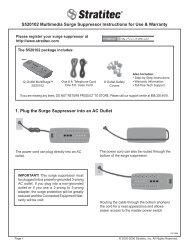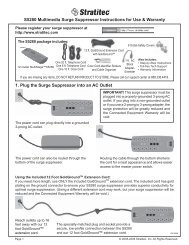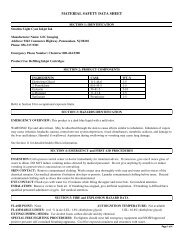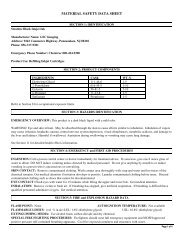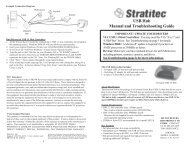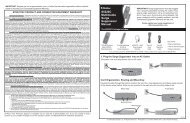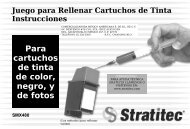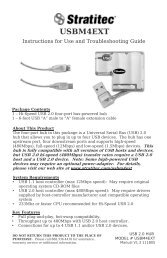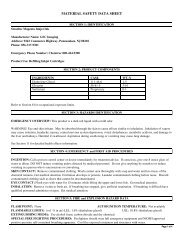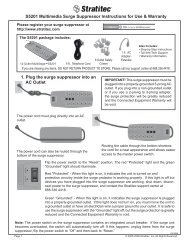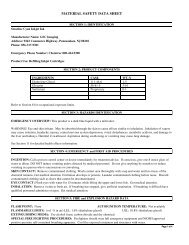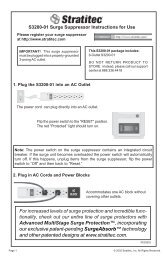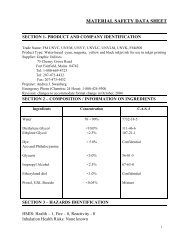MSDS for Black Ink - Stratitec
MSDS for Black Ink - Stratitec
MSDS for Black Ink - Stratitec
You also want an ePaper? Increase the reach of your titles
YUMPU automatically turns print PDFs into web optimized ePapers that Google loves.
MATERIAL SAFETY DATA SHEET<br />
SECTION 1: IDENTIFICATION<br />
I400 EIR500MLKP Reinking <strong>Ink</strong> / Water-Base Pigment <strong>Ink</strong><br />
Distributor Name: <strong>Stratitec</strong>, Inc.<br />
Address: 3522 N Comotara, Wichita KS 67226<br />
Phone: 316.618.3500<br />
Emergency Phone Number: Chemtrec 800-424-9300<br />
Product Use: Refilling <strong>Ink</strong>jet Cartridges<br />
Date of Preparation: November 30, 2004<br />
SECTION 2: PRODUCT COMPONENTS<br />
INGREDIENTS CAS#. WT.%<br />
2-Pyrrolidone 616-45-5 10-20<br />
Carbon <strong>Black</strong> 1333-86-4 1-10<br />
Refer to Section 8 <strong>for</strong> occupational exposure limits.<br />
SECTION 3: HAZARDS IDENTIFICATION<br />
EMERGENCY OVERVIEW: This product is a black liquid with a mild odor.<br />
CAUTION! May cause mild eye and skin irritation. Inhalation of vapors or mists may cause irritation, headache, dizziness and<br />
other central nervous system effects. Swallowing may cause kidney damage.<br />
See Section 11 <strong>for</strong> detailed health effects in<strong>for</strong>mation.<br />
SECTION 4: EMERGENCY and FIRST AID PROCEDURES<br />
INGESTION: Call a poison control center or doctor immediately <strong>for</strong> treatment advice. If conscious, give one 8 ounce glass of<br />
water to dilute. DO NOT induce vomiting unless directed by medical personnel. Do not give anything by mouth to or induce<br />
vomiting in a person who is unconscious or convulsing.<br />
SKIN CONTACT: Remove contaminated clothing. Wash contact area thoroughly with soap and water. Get medical attention<br />
if irritation develops and persists. Launder contaminated clothing be<strong>for</strong>e reuse. Discard contaminated clothing such as shoes<br />
that cannot be decontaminated.<br />
EYE CONTACT: Flush eyes with water while lifting the upper and lower lids. Get medical attention.<br />
INHALATION: Remove victim to fresh air. If breathing has stopped, give artificial respiration. If breathing is difficult have<br />
qualified personnel administer oxygen. Get medical attention.<br />
SECTION 5: FIRE and EXPLOSION HAZARD DATA<br />
FLASH POINT: None<br />
AUTOIGNITION TEMPERATURE: Not available<br />
FLAMMABLE LIMITS: (vol % in air) LEL: Not applicable<br />
UEL: Not available<br />
EXTINGUISHING MEDIA: Use media appropriate to the surrounding fire.<br />
SPECIAL FIRE FIGHTING PROCEDURES: Firefighters should wear full emergency equipment and NIOSH approved<br />
positive pressure self-contained breathing apparatus. Cool fire exposed containers and structures with water.<br />
UNUSUAL FIRE AND EXPLOSION HAZARDS: None known.<br />
HAZARDOUS COMBUSTION PRODUCTS: Carbon monoxide, carbon dioxide, tetrahydrofuran and oxides of nitrogen.<br />
SECTION 6: ACCIDENTAL RELEASE MEASURES<br />
Page 1 of 4
STEPS TO BE TAKEN IN CASE MATERIAL IS RELEASED OR SPILLED: Wear appropriate protective clothing as<br />
described in Section 8. Dike spill and absorb with inert material. Collect into closable containers <strong>for</strong> proper disposal. Report<br />
spill as required by local and federal regulations.<br />
SECTION 7: HANDLING and STORAGE<br />
PRECAUTIONS TO BE TAKEN IN HANDLING AND STORING: Protect containers from physical damage. Store in a<br />
cool, dry area away from oxidizers and other incompatible materials.<br />
Avoid contact with eyes, skin and clothing. Avoid breathing vapors. Use with adequate ventilation. Remove and launder<br />
contaminated clothing be<strong>for</strong>e re-use. Wash thoroughly after handling and be<strong>for</strong>e eating, drinking, smoking or using toilet<br />
facilities.<br />
OTHER PRECAUTIONS: Empty containers retain product residues and are hazardous. Follow all <strong>MSDS</strong> precautions in<br />
handling empty containers.<br />
SECTION 8: EXPOSURE CONTROLS and PERSONAL PROTECTION<br />
INGREDIENTS CAS#. EXPOSURE LIMITS<br />
2-Pyrrolidone 616-45-5 None Established<br />
Carbon <strong>Black</strong> 1333-86-4 3.5 mg/m 3 TWA OSHA PEL<br />
3.5 mg/m 3 TWA ACGIH TLV<br />
VENTILATION: Provide adequate general or local exhaust ventilation to maintain vapor concentrations below the exposure<br />
limits.<br />
RESPIRATORY PROTECTION: Use NIOSH approved respirator with organic vapor cartridges or supplied air respirator if<br />
needed. Selection of respiratory protection depends on the contaminant type, <strong>for</strong>m and concentration. Select in accordance with<br />
OSHA 1910.134 and good Industrial Hygiene practice.<br />
EYE PROTECTION: Chemical safety goggles and faceshield if splashing is possible.<br />
PROTECTIVE CLOTHING: Butyl rubber or other impervious gloves are recommended. Impervious apron, boots and other<br />
clothing are recommended if needed to prevent contact or if splashing is possible.<br />
OTHER PROTECTIVE EQUIPMENT: For operations where contact can occur, an eye wash facility should be immediately<br />
available.<br />
SECTION 9: PHYSICAL and CHEMICAL PROPERTIES<br />
BOILING POINT (@760 mmHg): 212F<br />
FREEZING POINT: -Not available<br />
SPECIFIC GRAVITY (H20=1): 1.06<br />
COEFFICIENT of WATER/OIL: Not available<br />
VAPOR PRESSURE: 17.5 mmHg<br />
EVAPORATION RATE: < Butyl Acetate<br />
VAPOR DENSITY (Air=1): Heavier than air pH: 7.0 -8.5<br />
SOLUBILITY IN WATER: Complete<br />
APPEARANCE AND ODOR: <strong>Black</strong> liquid with a mild odor.<br />
SECTION 10: STABILITY and REACTIVITY<br />
STABILITY: Stable.<br />
CONDITIONS TO AVOID: None known.<br />
INCOMPATIBILITY: Strong oxidizing agents, acids and strong hydrogen peroxide.<br />
HAZARDOUS DECOMPOSITION PRODUCTS: Thermal decomposition may yield carbon monoxide, carbon dioxide,<br />
tetrahydrofuran, and nitrogen oxides.<br />
HAZARDOUS POLYMERIZATION: Will not occur.<br />
SECTION 11: TOXICOLOGICAL INFORMATION<br />
EYE CONTACT: May cause mild irritation with redness and tearing.<br />
SKIN CONTACT: Prolonged contact may cause mild skin irritation.<br />
Page 2 of 4
INHALATION: Vapors or mists may cause respiratory irritation with headache, dizziness, drowsiness, narcosis, constriction<br />
of the pupils and loss of reflexes.<br />
INGESTION: Swallowing may cause gastrointestinal irritation, nausea, vomiting, diarrhea, narcosis, construction of pupils,<br />
increased blood sugar levels and loss of reflexes. May cause damage to the kidneys.<br />
CHRONIC EFFECTS of OVEREXPOSURE: Carbon black has been found to be mutagenic is some test systems. 2-<br />
pyrrolidione was found to cause birth defects in studies with laboratory animals.<br />
CARCINOGENICITY: Carbon black is listed as “Possibly Carcinogenic to Humans” (Group 2B) by IARC.<br />
MEDICAL CONDITIONS AGGRAVATED BY EXPOSURE: Individuals with chronic respiratory and skin diseases may<br />
be at increased risk from exposure to this material.<br />
TOXICOLOGY DATA: Toxicity values <strong>for</strong> this chemical are:<br />
2-Pyrrolidone:<br />
Carbon <strong>Black</strong>:<br />
Oral rat LD50: 6,500 mg/kg<br />
Oral rat LD50 >15,400 mg/kg<br />
Skin rabbit LD50 >3,000 mg/kg<br />
SECTION 12: ECOLOGICAL INFORMATION<br />
2-Pyrrolidone:<br />
Carbon <strong>Black</strong>:<br />
EC50/48 hour daphnia magna >500 mg/l<br />
LC50/48 hour golden orfe >500 mg/l<br />
LC50/96 hour fathead minnow >100 mg/l<br />
EC50/24 hour daphnia magna >1,000 mg/l<br />
SECTION 13: DISPOSAL INFORMATION<br />
WASTE DISPOSAL METHOD: Dispose of in accordance with all local, state and federal regulations.<br />
DOMESTIC TRANSPORTATION<br />
SECTION 14: TRANSPORTATION INFORMATION<br />
DOT SHIPPING NAME: Not Regulated<br />
DOT HAZARD CLASSIFICATION: Not Regulated<br />
DOT LABELS REQUIRED (49CFR172.101): Not Applicable<br />
UN NUMBER: None<br />
INTERNATIONAL TRANSPORTATION<br />
IMDG SHIPPING NAME: Not Regulated<br />
IMDG CLASS: Not Regulated<br />
UN NUMBER: Not Applicable<br />
IMDG LABEL: None<br />
SECTION 15: REGULATORY INFORMATION<br />
OSHA HAZARD CLASSIFICATION: Irritant, target organ effects, carcinogen<br />
EPA SARA 311 HAZARD CLASSIFICATION: Acute health, chronic health<br />
SARA TITLE 111 SECTION 313 INFORMATION: This product contains the following chemicals that are regulated under<br />
SARA 313: None<br />
CERCLA HAZARDOUS SUBSTANCE (40CFR 116): Not applicable<br />
REPORTABLE QUANTITY: Not applicable<br />
STATE R-T-K COMPOSITION INFORMATION<br />
COMPONENT CAS # WT% PA MA<br />
Page 3 of 4
2-Pyrrolidone 616-45-5 10-20 Y Y<br />
Carbon <strong>Black</strong> 1333-86-4 1-10 Y Y<br />
CALIFORNIA PROPOSITION 65 INFORMATION: This product contains carbon black. Cali<strong>for</strong>nia lists carbon black<br />
(airborne, unbound particles of respirable size) as known to cause cancer. This product contains no unbound carbon black.<br />
There<strong>for</strong>e no warning is required.<br />
WHMIS CLASSIFICATION: Class D - Division 2 - Subdivision A (Very toxic material causing other toxic effects)<br />
SECTION 16: OTHER INFORMATION<br />
NFPA Rating: Health = 1 Fire = 0 Reactivity = 0<br />
HMIS Rating: Health = 1 Fire = 0 Reactivity = 0<br />
Page 4 of 4



